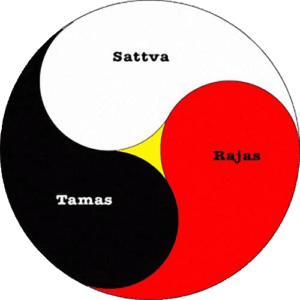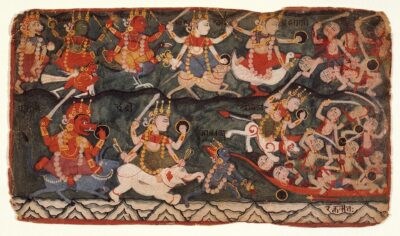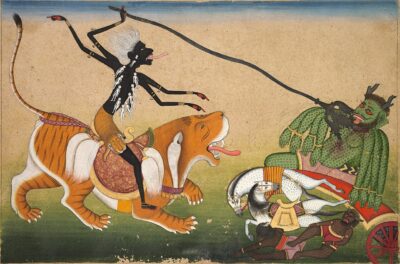Sakti: Power Immanent
*Published in The Times of India, New Delhi, May 29, 1998
The late C. V. Seshadri, while discussing the concept of energy, wrote, “many concepts that are accepted as absolutely self-evident…are really based on very deep-seated cultural roots that need not necessarily be universal.” The ‘objective’ concept of space is one such and the Indian chemist cites the example of Newton who beheld space and God to be synonymous as he was “merely following a well-rooted tradition of the religions of the Middle-East.” Seshadri himself ventured to propose the idea of sakti, an evolutionary form of power, as a “native ethos” of the concept of energy. It suggests that given his entrenched roots in Hinduism, the scientist perhaps had held energy and God to be the one and the same.
 Sakti, that is energy, strength or power, is the feminine noun of the Sanskrit verb Sak, meaning, to be strong or powerful or to be capable of strength and power. To the Hindu, Sakti is the creative impulse inherent within the Brahman or the Divine Absolute, which activates the process of creation, sustains the universe and then subsequently destroys it. It is not only the primordial energy but also the material matrix itself in which the manifest world is grounded and in that sense Sakti is at once latent and manifest, both static and kinetic. It is the manifestation of the unmanifest, great void of the Nirguna Brahman as the five gross elements of ether, air, fire, water and earth, the triptychs of heat, water, food; red, white and black; the sattva, rajas and tamas; the sixteen vikaras and the twenty-four tattvas. Sakti is speech as sabdbrahman, the masculine as purusa and the all-pervading Omnipresence as cit or consciousness.
Sakti, that is energy, strength or power, is the feminine noun of the Sanskrit verb Sak, meaning, to be strong or powerful or to be capable of strength and power. To the Hindu, Sakti is the creative impulse inherent within the Brahman or the Divine Absolute, which activates the process of creation, sustains the universe and then subsequently destroys it. It is not only the primordial energy but also the material matrix itself in which the manifest world is grounded and in that sense Sakti is at once latent and manifest, both static and kinetic. It is the manifestation of the unmanifest, great void of the Nirguna Brahman as the five gross elements of ether, air, fire, water and earth, the triptychs of heat, water, food; red, white and black; the sattva, rajas and tamas; the sixteen vikaras and the twenty-four tattvas. Sakti is speech as sabdbrahman, the masculine as purusa and the all-pervading Omnipresence as cit or consciousness.
 The enigma of Sakti may be contemplated at various levels. It is extolled most frequently as the Divine Feminine, crystallized in the persona of the Great Goddess who displays her dimensions in a variegated maze of deific incarnations. The Devi Mahatmya of the Markandeya Purana depicts the creative, sustaining and destructive aspects of Sakti in a trinity of deities: the molten gold, sublime glory of Mahalakshmi, the pristine, moonlit, refinement of Mahasarasvati and the dark, carnal image of the skull-garlanded Mahakali. These sublime, gentle and furious aspects of Sakti, also known as the goddesses Vac-Saraswati, Ratri and Sri in the Vedic scriptures, are the markers of energy in Hinduism. Between these three nodalities, a multitude of microdimensions of Energy are played out as the benevolent nurturer, the universal mother, the protector, the refuge, the bountiful, the procreator, the consort, the virgin, the ascetic, the warrior, the fiend and the downright terrible. Each of these dimensions of Sakti is graphically represented by a corresponding image of a goddess.
The enigma of Sakti may be contemplated at various levels. It is extolled most frequently as the Divine Feminine, crystallized in the persona of the Great Goddess who displays her dimensions in a variegated maze of deific incarnations. The Devi Mahatmya of the Markandeya Purana depicts the creative, sustaining and destructive aspects of Sakti in a trinity of deities: the molten gold, sublime glory of Mahalakshmi, the pristine, moonlit, refinement of Mahasarasvati and the dark, carnal image of the skull-garlanded Mahakali. These sublime, gentle and furious aspects of Sakti, also known as the goddesses Vac-Saraswati, Ratri and Sri in the Vedic scriptures, are the markers of energy in Hinduism. Between these three nodalities, a multitude of microdimensions of Energy are played out as the benevolent nurturer, the universal mother, the protector, the refuge, the bountiful, the procreator, the consort, the virgin, the ascetic, the warrior, the fiend and the downright terrible. Each of these dimensions of Sakti is graphically represented by a corresponding image of a goddess.

 At another level, Sakti is the reflection of the internal vagaries of human nature and the Supreme Being assumes Its appropriate Sakti-rup (form) to grapple with the needs of the times. Destructive-time or pralay manifests Sakti in her aggressive forms in order to annihilate the bestial or asuric qualities within man, described so poignantly in the Ratrisuktam of the Rig Veda. The higher the degree of banality in the created universe, the more ferocious the image of Sakti. The tale of the battle with the great asuras, Shumbh and Nishumbh, succinctly portrays the transitional emergence of Sakti from Parvati, the serene daughter of the Himalayas to the exquisite beauty of the Goddess Ambika, the ferocious blood-drinking Chamunda and finally the hideous, terrifying form of Shivaduti, whose battle-cry ripped apart the universe and chilled the hearts of many an asura.
At another level, Sakti is the reflection of the internal vagaries of human nature and the Supreme Being assumes Its appropriate Sakti-rup (form) to grapple with the needs of the times. Destructive-time or pralay manifests Sakti in her aggressive forms in order to annihilate the bestial or asuric qualities within man, described so poignantly in the Ratrisuktam of the Rig Veda. The higher the degree of banality in the created universe, the more ferocious the image of Sakti. The tale of the battle with the great asuras, Shumbh and Nishumbh, succinctly portrays the transitional emergence of Sakti from Parvati, the serene daughter of the Himalayas to the exquisite beauty of the Goddess Ambika, the ferocious blood-drinking Chamunda and finally the hideous, terrifying form of Shivaduti, whose battle-cry ripped apart the universe and chilled the hearts of many an asura.
The Hindu philosophical legacy has glorified the different aspects of the Paramatman and his eternal play of Energy in particular times in history. The Vedantists for example, perceived the eternal, unchanging Absolute and the manifest Sakti or prakrti in unity. On the other hand, the Samkhya philosophers, who executed the most elaborate discussion on prakrti, believed in the dualism of the Brahman and Sakti. The Puranas, celebrated the many dimensions of the Self and Sakti through the grand narratives of mythography, where the drama of Sakti is described in its masculine and feminine forms, Vishnu/Shiv and Kali, with captivating vividness. Finally, the Tantrashastras, also known as ‘practical/applied Vedanta’, have worshipped the Brahman exclusively through and as Sakti, the worship of the Supreme Self equally in its abstract and gross incarnations. The Tantras thus embody the most extensive description of Sakti worship, ritually as well as philosophically, worshipping their presiding deity, the fearsome Kali as Bhramasvarupini.

Sakti is the eternal flow between the progeniture (birth) and the putrescent (death), the Brahman (unmanifest) and the Shiv (manifest). At times tranquil and at times turbulent. Sometimes hidden, like a coiled serpent (kundalini) and sometimes resplendent like the infinite-petalled lotus (sahasrar padma). For the Hindu, there is no escape from the ebb and flow of its tide, as he/she is swirled through the vibrant glow of this Primordial Energy, that is Sakti.
![]()

0 comments